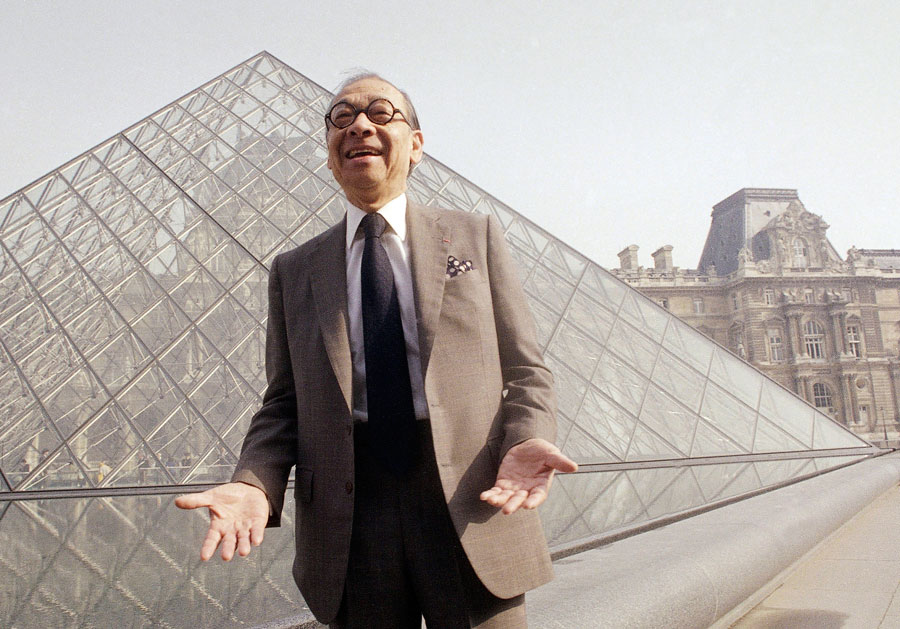The legacy of American architect I.M. Pei stretches from west to east, from the Louvre museum to his native China, where he helped fuse tradition and modernity as the country opened up after the Cultural Revolution.
Pei, who died earlier this week at the age of 102, added elegance to landscapes worldwide with powerful geometric shapes and grand spaces, from a trapezoidal addition to the National Gallery of Art in Washington, DC, to the giant glass pyramid at the Louvre.
Born in southern China, he migrated to the United States and was one of the first overseas architects to visit China during its initial period of opening up, said Tan Xin, a garden designer who worked with him in the early 1980s on the Fragrant Hill Hotel, which still stands on the outskirts of Beijing.
Pei was highly influential in helping Chinese architects and landscapers imagine how Chinese architecture could be modernized while retaining its traditional elements.
'He was so modest and unassuming,' Tan said in an interview Friday at her Beijing office. 'Even though he was Chinese American, he loved China and traditional Chinese culture.'
His works in Asia include the Fragrant Hill, or 'Xiangshan' in Chinese, a museum in the southeastern Chinese city of Suzhou and the striking steel and glass Bank of China skyscraper in Hong Kong.
The Suzhou Museum thanked Pei in a social media post for inspiring everyone at the museum, which it called a most precious gift to the city's residents.
Pei, who as a schoolboy in Shanghai was inspired by its building boom in the 1930s, studied architecture at the Massachusetts Institute of Technology and Harvard University. He advanced from his early work of designing office buildings, low-income housing and mixed-used complexes to a worldwide collection of museums, municipal buildings and hotels.
His big break was in 1964, when he was chosen over many prestigious architects, such as Louis Kahn and Ludwig Mies van der Rohe, to design the John F. Kennedy Memorial Library in Boston.
At the time, Jacqueline Kennedy said all the candidates were excellent, 'But Pei! He loves things to be beautiful.' The two became friends.
A slight, unpretentious man, Pei developed a reputation as a skilled diplomat, persuading clients to spend money on his grand-scale projects and working with a cast of engineers and developers.
Some of his designs were met with much controversy, such as the 71-foot faceted glass pyramid in the courtyard of the Louvre museum in Paris. Then French President Francois Mitterrand, who personally selected Pei to oversee the decaying, overcrowded museum's renovation, endured a barrage of criticism when he unveiled the plan in 1984.
Many French vehemently opposed such a change to the symbol of their culture, once a medieval fortress and then a national palace. Some resented that Pei, a foreigner, was in charge.
But Mitterrand and his supporters prevailed and the pyramid was finished in 1989. It serves as the Louvre's entrance, and a staircase leads visitors down to a vast, light-drenched lobby featuring ticket windows, shops, restaurants, an auditorium and escalators to other parts of the vast museum.
'All through the centuries, the Louvre has undergone violent change,' Pei said. 'The time had to be right. I was confident because this was the right time.'
No challenge seemed to be too great for Pei, including the Rock and Roll Hall of Fame, which sits on the shore of Lake Erie in downtown Cleveland, Ohio. Pei, who admitted he was just catching up with the Beatles, researched the roots of rock 'n' roll and came up with an array of contrasting shapes for the museum. He topped it off with a transparent tent-like structure, which was 'open — like the music,' he said.
Pei officially retired in 1990 but continued to work on projects. Two of his sons, Li Chung Pei and Chien Chung Pei, former members of their father's firm, formed Pei Partnership Architects in 1992. Their father's firm, previously I.M. Pei and Partners, was renamed Pei Cobb Freed & Partners.
Ieoh Ming Pei (YEE-oh ming PAY) was born on April 26, 1917, in Canton, China, the city now called Guangzhou. He came to the United States in 1935 with plans to study architecture, then return to practice in China. However, World War II and the revolution in China prevented him from going back.
Pei established his own architectural firm in 1955, a year after he became a U.S. citizen. He remained based in New York City. Among the firm's accomplishments are the Jacob Javits Convention Center in New York City and the United States Holocaust Memorial Museum in Washington.
Pei's wife, Eileen, whom he married in 1942, died in 2014. A son, T'ing Chung, died in 2003. Besides sons Chien Chung Pei and Li Chung Pei, he is survived by a daughter, Liane.
